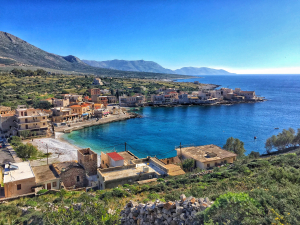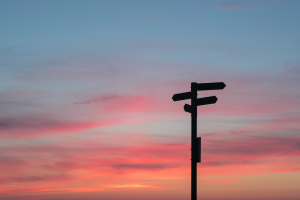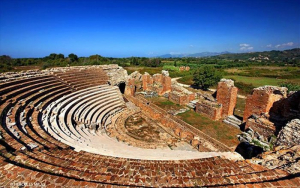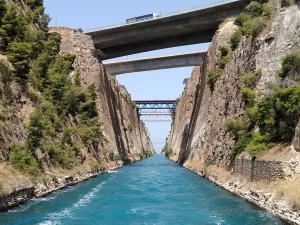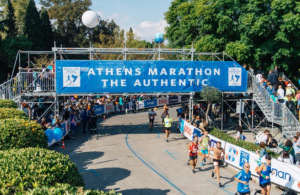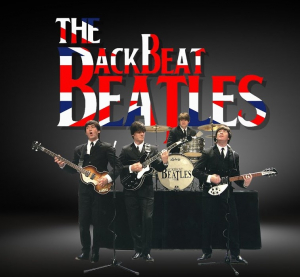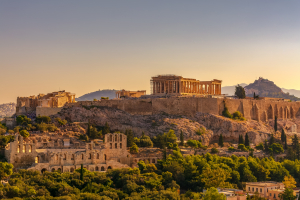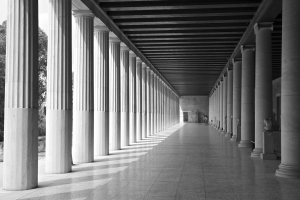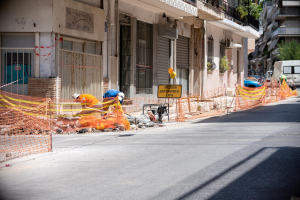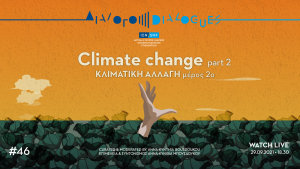ABOUT US
XpatAthens
Wednesday, 06 October 2021 07:00
Peloponnese. Greece Beyond the Obvious
A new tourism campaign to promote the Peloponnese region of Greece features a video called ‘Greece – beyond the obvious’ and showcases the beauty of locations such as Mani, Ancient Olympia, and Nafplio, highlighting that there is so much more to Greece than her islands.
The campaign, which has been winning over audiences, makes light of the stereotypical tourist who often fails to think beyond the Greek islands when imagining a holiday in Greece.
The video opens with text on the screen that reads: “We asked people the following question: What’s the first thing that comes to mind when you hear ‘Holidays in Greece?’”
“The islands” comes the reply from various tourists from around the world.
The humorous video cuts to a scene where the local “kafeneio” owner is explaining to the viewer how he has gathered all of the elderly men in the village together in order that they can all Google ‘Peloponnese’ to give the region a higher search ranking on Google.
The video forms part of the region’s ongoing tourism campaign aimed at establishing the Peloponnese as a leading destination to experience genuine Greece and traditional Greek hospitality.
“The first drink is on us!” the local “kafeneio” owner featured on the video promises prospective visitors.
In its first month on air, the 1.22-minute video has already exceeded 3 million views. It will be used to promote the region through social media outlets to major tourism markets, including Germany, France, Poland, Switzerland, and the UK.
To read this article in full, please visit: greekcitytimes.com
Published in
Travel Greece
Tagged under
Tuesday, 05 October 2021 07:00
How To Create Lasting Changes
Do you live the life you’ve always wanted or are you trying to fit in and be comfortable with an existing situation? Are you in control of your own life or do you just go where the situations and people around you go? Two of my clients recently admitted to themselves: “That’s not the relationship I’ve dreamed of with my partner and father of my two children.”Both of them are wonderful, smart, successful women and mothers – one has elementary school children and the other is a mom of two teenage boys. One is a working mom while the other has made the conscious decision to stay home and raise her children.
It’s not so difficult to answer this question but at times it is difficult to actually accept reality. Most of us believe we deserve to have what we say we want to have. It’s a subconscious belief. And when life is not what we think it should be for us, not only are we not happy but we also get very angry. The tricky part is that we blame others for what’s happening to us instead of taking responsibility. That is why we often sabotage ourselves. The way we do that is by being passive, not getting into action while at the same time waiting for someone else to make a move first.
How many times have you told yourself what you really want from a situation or a person and what you need to do? And how many times did you not do it because there was always a good excuse … because the other person, the conditions… it was not exactly what you expected … it did not happen as you had imagined it? I’m the first to admit, I’ve done it again and again.
Think about how it would be if you could break this vicious circle; break the belief that there is no hope for you to create on your own a worthy change that will last. Can you imagine what it would be like if you’d make your own decisions for yourself and take action today, now? How would you feel? “Will I need to move out of my comfort zone?” you may ask. “For sure” I’ll reply. It’ll probably feel uncomfortable or strange at the beginning. But it’s a start, an important first step towards creating your life the way you want it to be.
The key to your success is your mind. And if you want to live the life you dream of, you need to start by setting your personal growth goals. As Albert Einstein has said: “To live a happy life tie it to a goal, not to people or things.”
So, go ahead! 1. Choose your goal, 2. Commit to it and 3. Get into Action now. Because in the end it is not what we are capable of doing but what we actually do to make changes and bring the results we want.
Originally published on: itsmylife.gr
It’s not so difficult to answer this question but at times it is difficult to actually accept reality. Most of us believe we deserve to have what we say we want to have. It’s a subconscious belief. And when life is not what we think it should be for us, not only are we not happy but we also get very angry. The tricky part is that we blame others for what’s happening to us instead of taking responsibility. That is why we often sabotage ourselves. The way we do that is by being passive, not getting into action while at the same time waiting for someone else to make a move first.
How many times have you told yourself what you really want from a situation or a person and what you need to do? And how many times did you not do it because there was always a good excuse … because the other person, the conditions… it was not exactly what you expected … it did not happen as you had imagined it? I’m the first to admit, I’ve done it again and again.
Think about how it would be if you could break this vicious circle; break the belief that there is no hope for you to create on your own a worthy change that will last. Can you imagine what it would be like if you’d make your own decisions for yourself and take action today, now? How would you feel? “Will I need to move out of my comfort zone?” you may ask. “For sure” I’ll reply. It’ll probably feel uncomfortable or strange at the beginning. But it’s a start, an important first step towards creating your life the way you want it to be.
The key to your success is your mind. And if you want to live the life you dream of, you need to start by setting your personal growth goals. As Albert Einstein has said: “To live a happy life tie it to a goal, not to people or things.”
So, go ahead! 1. Choose your goal, 2. Commit to it and 3. Get into Action now. Because in the end it is not what we are capable of doing but what we actually do to make changes and bring the results we want.
Originally published on: itsmylife.gr
Published in
Mind
Tagged under
Tuesday, 05 October 2021 07:00
Greece's Hidden Archaeological Gems
Greece is one of the most important cultural hubs of the world, sprinkled with numerous archaeological sites. From the world-famous temple of Parthenon to the ancient theater of Epidaurus, there is so much one can discover. However, there are some lesser-known archaeological sites in the country that hold their own rich history, even though not many people have heard of them.
Here's a list of the lesser-known archaeological wonders of Greece, perfect for history aficionados and those who love sightseeing!
Nikopolis

Octavian Theater Nikopolis. Source: Harrygouvas/Wikimedia Commons
Located 7km north of Preveza, Nikopolis, the largest ancient city in Greece, was founded by Octavianus Augustus in 31 BC to commemorate his nearby victory over Antony and Cleopatra in the naval battle of Actium. Every four years, the city celebrated the Actia, festivals including athletic, musical and racing contests. Among the most important monuments that can be found in the area are the Theatre, the Odeum, the Monument of Augustus, and the Nymphaeum.
Here's a list of the lesser-known archaeological wonders of Greece, perfect for history aficionados and those who love sightseeing!
Nikopolis

Octavian Theater Nikopolis. Source: Harrygouvas/Wikimedia Commons
Located 7km north of Preveza, Nikopolis, the largest ancient city in Greece, was founded by Octavianus Augustus in 31 BC to commemorate his nearby victory over Antony and Cleopatra in the naval battle of Actium. Every four years, the city celebrated the Actia, festivals including athletic, musical and racing contests. Among the most important monuments that can be found in the area are the Theatre, the Odeum, the Monument of Augustus, and the Nymphaeum.
Ancient Calydon

Source: Vasarchit/Wikimedia Commons
The ancient city of Calydon is located about 10km from modern Mesolongi. According to tradition, the town was founded by Calydon, son of Aetolus, and it's mentioned by Homer as one of the five Aetolian cities that participated in the Trojan War. The site is also known for the Calydonian bear sent by Artemis to ravage the area because its king failed to honor her. Today, one can admire the temple of Artemis, Apollo, and Dionysus, as well as the ancient theater and the tomb of the Calydonian hero, Leo.

Source: Vasarchit/Wikimedia Commons
The ancient city of Calydon is located about 10km from modern Mesolongi. According to tradition, the town was founded by Calydon, son of Aetolus, and it's mentioned by Homer as one of the five Aetolian cities that participated in the Trojan War. The site is also known for the Calydonian bear sent by Artemis to ravage the area because its king failed to honor her. Today, one can admire the temple of Artemis, Apollo, and Dionysus, as well as the ancient theater and the tomb of the Calydonian hero, Leo.
Karthea

Source: Augusto Gasbarri/wondergreece.gr
Karthea is the most important of the four ancient city-states of the Cycladic island of Kea. It was founded in the Archaic times and survived until the early Byzantine times. Little remains today from the ancient town, however, the route there is very popular for trekking. Some of the most interesting monuments in Karthea include the Doric temple of goddess Athena and the archaic Temple of Pythion Apollo (530 BC). The Archeological Museum of Kea exhibits parts of this fascinating ancient city.

Source: Augusto Gasbarri/wondergreece.gr
Karthea is the most important of the four ancient city-states of the Cycladic island of Kea. It was founded in the Archaic times and survived until the early Byzantine times. Little remains today from the ancient town, however, the route there is very popular for trekking. Some of the most interesting monuments in Karthea include the Doric temple of goddess Athena and the archaic Temple of Pythion Apollo (530 BC). The Archeological Museum of Kea exhibits parts of this fascinating ancient city.
Orraon

Source: Harrygouvas/Wikimedia Commons
Located in Epirus, the archaeological site of Orraon is sometimes described as the most well-preserved ancient settlement in Greece. It was founded in the 4th century BC, and in 31 BC it was abandoned by its inhabitants who were obliged to settle in Nikopolis. Apart from the exceptional preservation of the stone-built private houses, the defensive character of Orraon is truly remarkable. With massive fortification walls reinforced with towers, this city-fortress was located in a strategic position, guarding the passage from the Amvrakikos Gulf to the Ioannina basin.

Source: Harrygouvas/Wikimedia Commons
Located in Epirus, the archaeological site of Orraon is sometimes described as the most well-preserved ancient settlement in Greece. It was founded in the 4th century BC, and in 31 BC it was abandoned by its inhabitants who were obliged to settle in Nikopolis. Apart from the exceptional preservation of the stone-built private houses, the defensive character of Orraon is truly remarkable. With massive fortification walls reinforced with towers, this city-fortress was located in a strategic position, guarding the passage from the Amvrakikos Gulf to the Ioannina basin.
Asklepion

Source: Michal Osmenda/ Wikimedia Commons

Source: Michal Osmenda/ Wikimedia Commons
Lying off the beaten track for most tourists, Asklepion is perched high above the harbor of the island of Kos. In antiquity, the site served as a sanatorium, and, as the name hints, it was dedicated to Aesculapius, son of Apollo, god of medicine and healing. The site consists of three terraces, the highest one enjoying a breathtaking view of the town of Kos. It might be high up, but admiring the amazingly well-preserved temple is rewarding.
Published in
Greek Philosophy & History
Tagged under
Monday, 04 October 2021 07:00
The Corinth Canal & The History Behind It
The Corinth Canal is one of the most important constructions of modern Greece, which played a catalytic role in Mediterranean trade.
Designed by Greek engineer Petros Protopapadakis its length is almost 6.5 kilometers and it is 25 meters wide. The Corinth Canal connects the Corinth Gulf with the Saronic Gulf and is an important passage that once allowed ships to enter the Aegean Sea, however, it is now impassable to contemporary ships.
The canal was built in 1893, 25 centuries after the conception of its idea, as it remained a dream for more than 2,000 years. Before its construction, ships in the Aegean Sea who intended to travel to the Adriatic or anchor in Corinth, a prosperous shipping center back then, had to circumnavigate the Peloponnese, adding an extra 185 nautical miles to their route.
History of the Corinth Canal
Back in the 7th century B.C., Periander, the tyrant of Corinth, decided to connect the Gulf of Corinth with the Saronic Gulf but his plans remained unaccomplished. Legend has it that the oracle advised him against the idea of building a canal and he, afraid of having to endure the wrath of the Gods, abandoned the project.
After about two and a half centuries, the Romans attempted to build the canal, however, every emperor that tried to do so, including Julius Caesar, Caligula, and Nero, died before the canal was completed.
In 1830, Ioannis Kapodistrias, Greece's first governor, opted to continue with the major project. The idea of reopening the Isthmus surfaced once more. Ioannis Kapodistrias assigned the project to Virle d' Uct, a French engineer who estimated that the building would require around 40 million gold francs, an enormous amount of money for the newly-founded Greek State.
In 1869, with the inauguration of the Suez Canal, the Greek government reconsidered its own canal. Prime Minister Thrasyvoulos Zaimis at the time, passed a law in 1870 authorizing the construction of a Corinth Canal and a French company was hired to oversee the project. It was not long before money became an issue again and the project came to an end.
Then in 1881, the Société Internationale du Canal Maritime de Corinthe was commissioned to build the canal and operate it for the next 99 years. King George, I of Greece was present when construction began in April 1882. After eight years of work, it ran out of money, and in 1890, construction resumed when the canal project was transferred to a Greek company. The canal was finally completed in July 1893.
Published in
Greek Philosophy & History
Tagged under
Monday, 04 October 2021 07:00
Going The Distance: A Guide To The Athens Marathon
490BC. The Persians fall at the Battle of Marathon, despite outnumbering the Athenians four to one. An Athenian herald named Pheidippides is dispatched to Athens, 42km away, to break the news. Once there, he utters the joyous words, νικῶμεν (nikomen)—“we have won”—and collapses. Most historical accounts then have him dying on the spot from exhaustion. This may or may not be a romanticized version of the events; though to be fair, Pheidippides had also just legged it 240km from Athens to Sparta and back again to ask for help when the Persian fleet landed in a bay near the town of Marathon.
Today, more than 1,500 marathon races are organized worldwide. But Greece is where it all began. At the first modern Olympic Games in Athens in 1896, a 42km race from Marathon to Athens featured as one of the defining events of the new Olympic era. It was a way of recalling the ancient glory of Greece. Fittingly, a Greek water-carrier, Spyridon Louis, won the race in 2 hours, 58 minutes, and 50 seconds. (Currently, Kenyan runner Felix Kandie holds the Athens Marathon record at 2 hours, 10 minutes, and 37 seconds.) Every year, long-distance runners from across the globe challenge their bodies and spirits to retrace the legendary footsteps of Pheidippides. With its combination of hills, heat, and history, many find it to be the toughest—but most poetic—Marathon route of them all.
What it’s like to run the Athens Marathon
Every year at 9 am on the day of the race, locals and visiting spectators line the streets of Marathon, where the ancient battlefield once stood, to cheer on jittery competitors at the starting blocks. Today, Marathon is a modest coastal town of about 8,000 residents, with a small archeological museum and an artificial lake. The runners pass around the Marathon Tomb, the final resting place of the Greek soldiers who lost their lives during the legendary battle of the Marathon. They then run near the base of Mount Penteli, onward to Pallini, and finally hit the streets and suburbs of the Greek capital.
Those who’ve run the classic Athens Marathon before—or done their homework—know to dread the uphill stretch after Rafina at around the 18km mark. This goes on until about 32km when the route shifts gently downhill to reach the wide, crowd-thronged avenues of the city centre. From there, it’s like a race through history.
Spectator sport: the best spots to watch the Marathon
Head to the stadium around 10-10.30 am to secure a seat on the marble tiers. You can soak up the party atmosphere and catch the first victorious runners entering the stadium, usually, around 11 am. Try for a spot on either side of the stadium entrance or right at the back in the centre, where the actual finish line is.
Head to the stadium around 10-10.30 am to secure a seat on the marble tiers. You can soak up the party atmosphere and catch the first victorious runners entering the stadium, usually, around 11 am. Try for a spot on either side of the stadium entrance or right at the back in the centre, where the actual finish line is.
Some other great vantage points are at the 40km mark, outside the Megaron Athens Concert Hall, or a bit further up Vasilissis Sofias Avenue, outside the Hilton hotel. This is where the runners really need you to cheer them on for their final burst of endurance. There’s a grassy pocket across the road from the Hilton that makes a symbolic spectator’s choice. It’s right next to Dromeas (The Runner), a 12-meter tall glass and iron sculpture by local artist Costas Varotsos.
Instagram addicts should head a little further out of the city centre to the Katehaki pedestrian bridge at the 37.5km mark, where you can snap a dramatic aerial view of the colorful stream of runners as they pass below (the closest metro station is Ethniki Amyna).
Run your own best race
The Athens Marathon isn’t just for professional athletes. Thousands of ordinary people from Athens and all over the world register for the other running races that take place on the sidelines: there’s a 5km, 10km, Power Walking Race, 1.2km Special Olympics Race, or even a Kids Race (registration for the Athens Marathon usually closes about two and a half months before the race, but you can still sign up for the side events until much later). Depending on your fitness levels, these are all great ways to feel part of this momentous experience.
The Athens Marathon isn’t just for professional athletes. Thousands of ordinary people from Athens and all over the world register for the other running races that take place on the sidelines: there’s a 5km, 10km, Power Walking Race, 1.2km Special Olympics Race, or even a Kids Race (registration for the Athens Marathon usually closes about two and a half months before the race, but you can still sign up for the side events until much later). Depending on your fitness levels, these are all great ways to feel part of this momentous experience.
To read this article in full, please visit: thisisathens.org
Whether you've just arrived in town – or have been here for years – Athens always has new secrets to share!
This is Athens is the official guide to this captivating city of ancient energies and booming urban culture. Compiled by a team of specialist local writers, This is Athens brings you an authentic and intimate portrait of a living Athens beyond the guidebooks – along with daily curated listings of all the best events and great weekend inspiration all-year round. From must-know neighbourhoods and emerging art hubs, to gourmet hotspots, cool shopping and the buzziest bars, This is Athens will help you to get the most out of living in Athens!
Thank you This is Athens for your contribution as an XpatAthens Partner.
Published in
Everyday Tips & How To’s
Tagged under
Tuesday, 28 September 2021 16:34
Christmas Theater - The Back Beat Beatles
The best musical tribute of the legendary Beatles is coming to Athens!
Back Beat Beatles is perhaps the best Beatles show ever presented, with world known stars such as Take That, Robbie Williams, Shirley Bassey and the Liverpool Symphony Orchestra having starred in this fascinating tribute..
The show follows the famous band through all phases of its career and pays tribute to their greatest hits, such as Yesterday, Let It Be, Love Me Do, Help and many more.
The performance begins in 1959 Liverpool, the city the legendary Beatles were formed, featuring voices of amazing resemblance to that of the original band, along with unique 1960's costumers that will take you back to that day and era!
The performance begins in 1959 Liverpool, the city the legendary Beatles were formed, featuring voices of amazing resemblance to that of the original band, along with unique 1960's costumers that will take you back to that day and era!
Get ready for a thrilling experience filled with the songs you love!
Published in
Music
Tagged under
Tuesday, 28 September 2021 07:00
Greece Ranked Second For Global Cultural Heritage Influence In 2021
CEOWORLD magazine has determined the world’s best countries for cultural heritage influence, by measuring their global influence in 9 country attributes: architecture, artistic legacy, fashion, food, music, literature, history, cultural attractions, and culturally accessible. Rather than economic, political, or military might, it’s the cultural heritage of these countries that most strongly impacts the wider world.
Italy took the prestigious number one spot, according to the CEOWORLD magazine 2021 report, while Greece and Spain placed second and third, respectively. The 2021 rankings placed India in fourth ahead of Thailand; while Portugal ranked sixth, and Japan seventh.
About Greece, the website said “the history development and culture of Greece has been a flagbearer for the whole world as a whole."
“From the Acropolis of Athens, Meteora to Temple of Apollo Epicurius at Bassae, the impressive architectural monuments make Greece a definite visit in many ways.”
To read this article in full, please visit: greekcitytimes.com
Published in
Greece In The News
Tagged under
Tuesday, 28 September 2021 07:00
The Story Of Modern Athens Through Its Architecture
Athens will surprise you with its diversity of design. If at first glance, the city appears to lack a coherent architectural style, that’s only because it’s highly individualistic. Even the most seemingly nondescript street harbors architectural quirks from different periods. Just tilt your head skywards to see Rococo railings and Art Deco porthole windows, capstones, and gables on buildings that mark different moments in the city’s layered history. Our virtual tour of some of the finest buildings in Athens tells the story of how the modern Greek capital took shape.
1830 to 1900

Credit: Georgios Makkas
Athens is established as the capital of Greece and the modern metropolis takes shape. Drawing inspiration from ancient Greece, architects introduce neoclassical elements. Impressive public buildings dominate a landscape of low-rise, stand-alone residences with gardens.

Credit: Georgios Makkas
Athens is established as the capital of Greece and the modern metropolis takes shape. Drawing inspiration from ancient Greece, architects introduce neoclassical elements. Impressive public buildings dominate a landscape of low-rise, stand-alone residences with gardens.
Doric columns and a triangular pediment dwarf this school building, completed in 1876 by noted architect Panayotis Kalkos. He also designed the first Acropolis Museum, a small stone building close to the Parthenon. This building is still used as a primary school, although it sits rather incongruously among the souvenir shops in the heart of Plaka.
Building Location: 106-108 Adrianou
The 1900s

Credit: Georgios Makkas
The emphasis shifts from public buildings to private residences, as the city’s elite display their wealth in luxurious mansions with eclectic flourishes.

Credit: Georgios Makkas
The emphasis shifts from public buildings to private residences, as the city’s elite display their wealth in luxurious mansions with eclectic flourishes.
This stately mansion harks back to the era when Kypseli was known for its splendid residences. Classical elements are overpowered by Italianate flourishes, so it’s fitting that it housed the Casa d’Italia before the First World War. Today it’s a public school.
Building Location: 46 Kypselis & Paxon
The 1910s

Credit: Georgios Makkas

Credit: Georgios Makkas
Many of the city’s leading architects of this period studied in France, so the Gallic influence is much in evidence.
This two-story Exarchia residence in the Beaux-Arts style is stunning, with its rounded corner tower, vaulted entrances, and subtle embellishments.
Building Location: 175 Ippokratous
The 1920s


Credit: Georgios Makkas
Architects turn back towards their Greek roots, seeking inspiration from Byzantine and folk art.
It looks like a single residence in Exarchia, but it’s actually two. A fact carefully concealed by the mix of neoclassical elements, like the pediments over the windows and neo-Baroque embellishments on the façade.
Building Location: 38A Eressou
The 1930s


Credit: Georgios Makkas
An urban middle class emerges, giving rise to the polikatikia or Athenian apartment block. Through its architecture, Athens embraces modernity but also glances nostalgically back.
Athens’ first New York-style skyscraper, this building originally housed a cinema, theatre, and ballroom. Its sheer façade and Art Deco elements, crafted from concrete, hide some ingenious acoustic engineering. It was restored in the 1980s after a fire and currently houses one of the National Theatre’s stages.
Building Location: 48 Panepistimiou Street
To read this article in full, please visit: thisisathens.org
To read this article in full, please visit: thisisathens.org
Whether you've just arrived in town – or have been here for years – Athens always has new secrets to share!
This is Athens is the official guide to this captivating city of ancient energies and booming urban culture. Compiled by a team of specialist local writers, This is Athens brings you an authentic and intimate portrait of a living Athens beyond the guidebooks – along with daily curated listings of all the best events and great weekend inspiration all-year round. From must-know neighbourhoods and emerging art hubs, to gourmet hotspots, cool shopping and the buzziest bars, This is Athens will help you to get the most out of living in Athens!
Thank you This is Athens for your contribution as an XpatAthens Partner.
Published in
City Discovery
Tagged under
Monday, 27 September 2021 07:00
Athens' Neighborhoods Are Getting New Sidewalks
A number of neighborhoods in Athens are getting new sidewalks as part of the municipality’s efforts to improve the everyday life of residents, enhance safety and ensure better accessibility for people with disabilities.
Reconstruction and maintenance works began last month and are currently underway. Already restored are the sidewalks of several streets in the 1st and 3rd city districts, including Ious Street, part of the Trion Ierarchon Street, and Amphipoleos Street. The remaining four city districts are expected to see construction works in October.
Within the next two years, a total of 410 new sidewalks are expected to be created in Athen's seven city districts. Under the budget of 24 million euros, the two-year plan emphasizes the energy upgrade of the sidewalks, controlling high temperatures, and fighting global warming and climate change. That's exactly why restoration works include the use of new environmentally friendly materials.
Apart from reconstruction and maintenance works, municipal crews are also widening the city’s sidewalks and planting trees in certain areas.
"It's a project that, once complete, the image of a friendly and modern city will be restored. These modern sidewalks will let Athenians walk safely in the city and actually enjoy it, something that should have been self-evident for years. Our primary concern in this process is to ensure safe access to people with disabilities, including the visually impaired.", said Kostas Bakoyiannis, mayor of Athens.
XpatAthens extends a warm thank you to This Is Athens and the City Of Athens for sharing news and inspiring stories about how Athens aspires to be a clean, friendly, and welcoming city to live in
XpatAthens extends a warm thank you to This Is Athens and the City Of Athens for sharing news and inspiring stories about how Athens aspires to be a clean, friendly, and welcoming city to live in
Published in
Local News
Tagged under
Monday, 27 September 2021 15:08
Climate Change - SNF Dialogues
Following a summer dominated by extreme weather events worldwide and an inexpressible national environmental disaster in Greece, there’s one question on everyone’s minds: Is there time to reverse the destruction humans have brought on the planet, or are we heading towards an inevitable and irreversible global climate crisis? Scientists tell us we may still have a small window of opportunity to halt global warming—not for the years ahead, where warming is all but guaranteed—but for the decades after 2050. Will humanity immediately make the courageous decisions required, knowing that its sacrifices will benefit not the planet’s current inhabitants, but the generations to come?
On Wednesday, September 29 at 18:30 (EET), the next SNF DIALOGUES event invites the public and representatives of the scientific community to a livestreamed open discussion about the future of humanity on a quickly warming planet.
Scientific data in a new report from the UN’s Intergovernmental Panel on Climate Change, prepared by 234 scientists from 66 countries, confirm beyond any doubt that our planet is getting hotter and that human beings are the cause. The consequences of this reality are already apparent. This past summer saw the first-ever rainfall in Greenland and a temperature of 49.6 degrees Celsius (121 degrees Fahrenheit) in Canada. An unprecedented heatwave hit Siberia and mega-fires broke out in Greece, Italy, Turkey, and the United States while deadly floods plagued Europe and China.
On Wednesday, September 29 at 18:30 (EET), the next SNF DIALOGUES event invites the public and representatives of the scientific community to a livestreamed open discussion about the future of humanity on a quickly warming planet.
Scientific data in a new report from the UN’s Intergovernmental Panel on Climate Change, prepared by 234 scientists from 66 countries, confirm beyond any doubt that our planet is getting hotter and that human beings are the cause. The consequences of this reality are already apparent. This past summer saw the first-ever rainfall in Greenland and a temperature of 49.6 degrees Celsius (121 degrees Fahrenheit) in Canada. An unprecedented heatwave hit Siberia and mega-fires broke out in Greece, Italy, Turkey, and the United States while deadly floods plagued Europe and China.
Faced with a climate crisis that seems, to a large extent, unavoidable and irreversible, the challenge now is to explore how to adapt to a new reality where natural disasters occur with increasing frequency and how to take action for future generations.
Published in
Community
Tagged under

